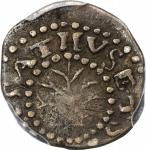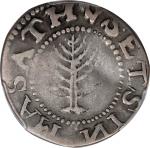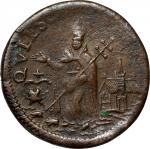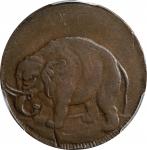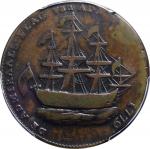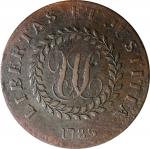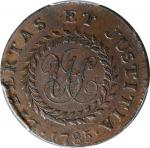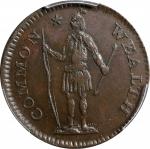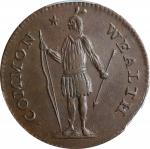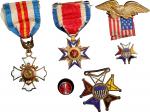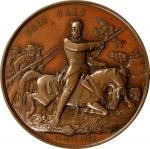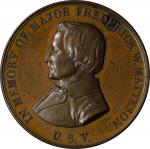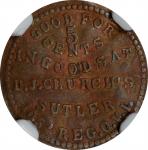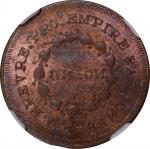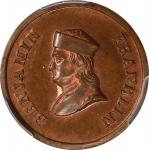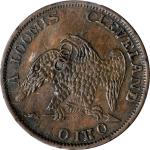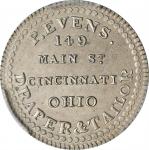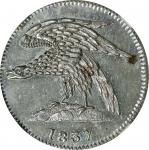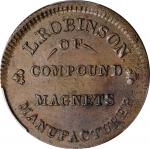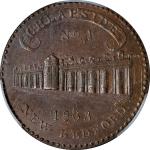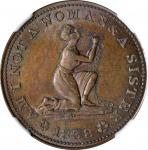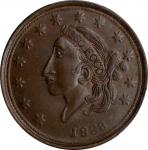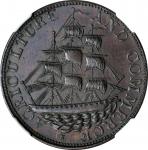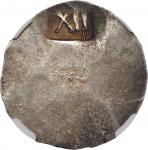Undated (1652) NE Shilling. Noe 3-B, Salmon 3-C, W-80. Rarity-7. MS-61 (NGC). 72.2 grains. As the first metallic currency struck in the Thirteen American Colonies , the NE coinage is easily one of the most famous - and important - of all colonial issues. Stacks Bowers Galleries is proud to present, in its first ever auction appearance in the United States, a recently discovered example of the Noe 3-B NE shilling. Graded MS-61 by NGC, this coin is the only Mint State NE shilling of any variety certified and is the finest known example of the type. Its offering in this sale is a landmark event for specialists in the silver coinage of Massachusetts Bay Colony and advanced collectors of U.S. colonial type coins . Aggressive bidding strategies are recommended for, once sold, it is likely that this numismatic treasure will be off the market for many years to come as part of a world class cabinet built wholly or in part around American colonial coinage.<p>The act passed on May 27, 1652, by the Massachusetts Bay Colony resulted in the first coins struck in British North America - in other words, the territory that would eventually become the United States. The establishment of a mint in the colony was in reaction to a shortage of circulating coinage as well as the problem of debased silver coins in commerce. John Hull was appointed mintmaster with Robert Sanderson, Sr. as his partner. They were the premier silversmiths in the British colonies at the time but lacked knowledge or experience as coiners. As such, the first coins that they produced for Massachusetts were made using the familiar techniques of silversmiths.<p>Since a proper press for striking coins was also still in the future for the colony, the first coins produced by Hull and Sanderson were made using simple device punches similar to those of a silversmiths hallmark. These punches sufficed since the General Court of the Massachusetts Bay Colony mandated that the first coins carry only an NE design on one side, for New England, and an expression of the denomination in Roman numerals on the other. This is the historic, famous and rare NE coinage produced in denominations of shilling, sixpence and threepence. The first examples were produced sometime after the authorizing act became valid on September 1, 1652, although the exact date is unknown. It is also not known how long NE coinage remained in production, but new legislation that required a more complex design for the colonys coinage was issued less than two months later, on October 19. According to traditional numismatic wisdom, the improvement in design was intended to combat the problem of clipping and shaving of the NE coins, practices made too easy by the simple design. Louis E. Jordan, in the reference <em>John Hull, the Mint and the Economics of Massachusetts Coinage</em> (2002), states that Hull and Sanderson acquired the colonys first proper press - a rocker press - in 1654. Some have concluded that NE coinage would have had to continue until then because the succeeding coins of the more complex Willow Tree design would have required the rocker press for proper production. Writing in the outstanding 2010 reference <em>The Silver Coins of Massachusetts</em>, however, Christopher J. Salmon argues conclusively that the Willow Tree coinage was produced using the same techniques as its NE predecessors. We can conclude, therefore, that coinage of NE shillings, sixpence and threepence was confined to a few weeks from early September through late October 1652. Mintages were certainly limited, due to both time and the challenges of any mints first coinage operations, especially one whose mintmaster and assistant were not skilled in their new craft and further burdened by the realities of living and working in 17th century New England.<p>The minting process for the NE shillings began when silver plate or Spanish colonial silver coins were brought to Hull and Sandersons shop for melting and assay adjusting to bring the fineness up the sterling quality. Exactly how the planchets were produced is unknown, but it was probably through hammering or pouring the molten silver into ingot molds and, once cooled, drawing on a bench through cast iron rollers. Christopher J. Salmon continues the process in his work on Massachusetts Bay Colony silver:<p><em>"The NE stamp was applied with a punch similar in appearance and style to a silversmiths touchmark or hallmark punch. This was done on the 12:00 position of the silver blank. The flan was then turned over and struck with the denomination punch at the reverse side of the 6:00 position, so selected for symmetry, and more importantly, to avoid marring or entirely obliterating the impression of the NE punch. The punches would probably have been hit sharply with a large hand-held hammer with the cold flan placed on the surface of a large steel anvil embedded in a tree trunk, according to standard silversmith methods of the time."</em><p>The punches that Hull and Sanderson used for the NE shillings wore down quickly, not surprising given their coining methods, and required regular recutting of the design elements to keep them usable. Writing in <em>The Colonial Newsletter</em> in 2010, Jack Howes demonstrated that all three NE shilling obverse punches are actually the same punch that had been significantly recut twice. Despite continual recutting, strikes from the punches were almost always incomplete, although this is also in keeping with silversmith practices of the time, hallmarks on contemporary silverware usually asymmetrical with one side of the mark slightly less defined than the other. Salmon ascribes this to "angulation of the punch during hammering."<p>Numismatic scholars have identified six different varieties of NE shilling, using three different states of the same NE punch and four distinct XII denomination punches. The offered coin is attributed as Noe 3-B, the obverse punch crudely recut from the slender (although impractical) lines of the Noe 2 state, resulting in angular rather than smoothly curved upper right and left serifs on the letter N. A distinct serif has also been added to the top horizontal of the E. Noe Reverse B is most readily identifiable by a prominent linear punch break from the lower right border that extends up across the lower left side of the second Roman numeral I. In later states this break expands to involve the bottom of the first Roman numeral I and the lower right side of the X.<p>Given the limited number of coins presumably struck and a high rate of attrition through commercial use and eventually melting, it is little wonder than the NE shilling as a type is an extreme numismatic rarity in the market of the 21st century. Including recent discoveries, no more than 65 examples of all varieties combined are believed extant, fully 22 of which are permanently impounded in institutional collections such as the American Numismatic Society, the British Museum, and the Smithsonian. Noe 3-B is a rare variety among a rare design type, and it was missing from some of the most important collections of Massachusetts silver ever formed, including Stearns, Garrett, Picker, Norweb, Roper, the Hain Family Collection, Massachusetts Historical Society (1970), and Oechsner. Only nine examples of this Noe number are positively confirmed to exist, as follows, with the grades of the uncertified pieces estimates:<p>1 - <strong>NGC MS-61.</strong> Ex Hon. Wentworth Beaumont; Morton & Eden, Ltd.s sale of the Beaumont Family Collection, Catalogue No. 113, November 2021, lot 1034. <em><strong>The present example</strong></em>, more background on which is given below.<p>2 - <strong>NGC AU-58.</strong> Ex New York Stamp & Coin Companys sale of the Robert Coulton Davis Collection, January 1890, lot 2352; Thomas Hall; Virgil Brand; Carl Wurtzbach (Plate Coin 4); T. James Clarke; F.C.C. Boyd; John J. Ford, Jr.; our (Stacks) sale of the John J. Ford, Jr. Collection, Part XII, October 2005, lot 2; Jon Hanson, October 18, 2005; Donald Groves Partrick; Heritages sale of the Donald Groves Partrick Collection, January 2015 FUN Signature Auction, lot 5517.<p>3 - <strong>PCGS AU-55.</strong> Ex Sothebys (London) Property of the Trustees of the Late Walter, Lord Cunliffe of Headley, the Property of E.J. Willes, Esq., etc., sale, May 1966, lot 154, via Spinks.; our sale of the Henry P. Kendall Foundation Collection, March 2015 Baltimore Auction, lot 2305.<p>4 - <strong>PCGS AU-53.</strong> Ex B. Max Mehls sale of the William Cutler Atwater Collection, June 1946, lot 1; B. Max Mehls sale of the Oliver E. Futter Collection, November 1954, lot 1965-A; R.R. Wilson, 1980; Alan V. Weinberg; Heritages sale of the Alan V. Weinberg Collection, Part III, January 2020 FUN Signature Auction, lot 4054.<p>5 - <strong>PCGS AU-53.</strong> Ex Abner Kreisbergs sale of October 1978, lot 2.<p>6 - <strong>PCGS EF-40.</strong> Discovered in Great Britain; ex our Americana Sale of January 2013, lot 10615; Heritages sale of the Poulos Family Collection, August 2019 Chicago ANA Signature Auction, lot 3630.<p>7 - <strong>Very Fine.</strong> Ex Thomas L. Elders sale of the Peter Gschwend Collection, June 1908, lot 1.<p>8 - <strong>Very Fine.</strong> Ex our (Stacks) sale of the Ellis Robison Collection, February 1982, lot 4; our (Stacks) March Sale, Part II, 1984, lot 915.<p>9 - <strong>Very Fine.</strong> Ex William B. Osgood Field; American Numismatic Society (Inv. 1946.89.72).<p>A possible tenth example was reported to be in the Clapp Collection, although its subsequent disposition is uncertain. It has been referred to as the Clapp-Stiles specimen, although in the firms January 2020 presentation of the Atwater-Futter-Weinberg specimen, the Heritage cataloger noted that the Kenneth Stiles NE shilling was a Noe 3-A coin.<p>The present example is CC#1 for the Noe 3-B attribution, and it is also the only Mint State NE shilling of any variety certified by PCGS and NGC. Its modern numismatic story began ahead of Morton & Edens November 2021 sale, when it was discovered in the United Kingdom in a tin containing numerous other coins and medals. The tin was the property of the Hon. Wentworth Beaumont, and the coin was subsequently sold in the Morton & Eden sale as ex Beaumont Family Collection. The catalogers noted:<p><em>"The shilling was probably acquired when new by William Wentworth (1616-97), an early Colonial settler. He is thought to have landed in New England in 1636 with John Wheelwright, the controversial antinomian who was related through marriage to Anne Hutchinson and who, in 1638, founded the town of Exeter in the area which was later to become New Hampshire.</em><p><em>"William Wentworth followed Wheelwright to Exeter and some of his many descendants - he was twice married and had 11 children - were to become highly distinguished in the new Province and, later, State, as well as the Continental Congress.</em><p><em>"…Although the possibility exists that it was obtained at a later date by one of Wentworths successors (who included one Lieutenant Governor and two Colonial Governors of New Hampshire), the presence in the family collection of several other well-preserved contemporary coins - the Commonwealth unite of 1650…for example - is felt to support the suggestion that William Wentworth himself obtained it when it was new."</em><p><p>This is an exceptional example of both the type and Noe number with richly original surfaces toned in dominant pewter-gray. The obverse also exhibits mottled russet overtones that are less pronounced on the reverse. Both punches are well executed, although they are typically asymmetrical with softer detail at the base of the NE punch and top of the XII punch. All design elements are fully appreciable, however, and they are generally crisp and near-fully defined. The break from the lowest horizontal of the letter E to the long, curving flourish of the N inherited from the Noe 2 state is plainly visible. The reverse is an early state of the punch with the break only involving the lower left side of the final Roman numeral I.<p>The surfaces of this coin are remarkable in that they retain the original, rough texture from when the planchet was produced. This texture was either imparted by the device that flattened or drew out the planchet or, if the former, the surface upon which the planchet was hammered. Very few NE silver coins of any denomination show even the barest trace of this original texture, usually because of extensive wear, but it is also likely that the original surfaces of the planchets varied widely regarding nature and extent of texture, as made. Regardless, there is no doubt that this coin retains far more of its original surfaces than any other NE shilling known to exist, fully justifying the CC#1 grade of MS-61 from NGC. The planchet is essentially round, and as close to such as one could realistically expect for the type, with only minor and shallow irregularities to the curvature.<p>As the finest certified and only Mint State example of Americas first coin - the famous and rare NE shilling - this is a numismatic treasure with few equals in todays market. It will surely have no difficulty finding its way into the finest colonial type set or advanced collection of Massachusetts Bay Colony silver. PCGS# 13. NGC ID: 2AR9. Combined PCGS and NGC Population (all varieties of the issue): just 1 in all Mint State grades. Ex Hon. Wentworth Beaumont; Morton & Eden, Ltd.s sale of the Beaumont Family Collection, Catalogue No. 113, November 2021, lot 1034. Discovered in the United Kingdom just prior to the Morton & Eden sale, this coin was found in a tin containing numerous other coins and medals. It was probably acquired by William Wentworth (1616-1697), an early settler in the American colonies who is thought to have landed in New England in 1636.


